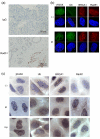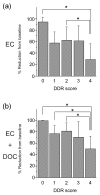Prediction of breast cancer sensitivity to neoadjuvant chemotherapy based on status of DNA damage repair proteins
- PMID: 20205718
- PMCID: PMC2879561
- DOI: 10.1186/bcr2486
Prediction of breast cancer sensitivity to neoadjuvant chemotherapy based on status of DNA damage repair proteins
Abstract
Introduction: Various agents used in breast cancer chemotherapy provoke DNA double-strand breaks (DSBs). DSB repair competence determines the sensitivity of cells to these agents whereby aberrations in the repair machinery leads to apoptosis. Proteins required for this pathway can be detected as nuclear foci at sites of DNA damage when the pathway is intact. Here we investigate whether focus formation of repair proteins can predict chemosensitivity of breast cancer.
Methods: Core needle biopsy specimens were obtained from sixty cases of primary breast cancer before and 18-24 hours after the first cycle of neoadjuvant epirubicin plus cyclophosphamide (EC) treatment. Nuclear focus formation of DNA damage repair proteins was immunohistochemically analyzed and compared with tumor response to chemotherapy.
Results: EC treatment induced nuclear foci of gammaH2AX, conjugated ubiquitin, and Rad51 in a substantial amount of cases. In contrast, BRCA1 foci were observed before treatment in the majority of the cases and only decreased after EC in thirteen cases. The presence of BRCA1-, gammaH2AX-, or Rad51-foci before treatment or the presence of Rad51-foci after treatment was inversely correlated with tumor response to chemotherapy. DNA damage response (DDR) competence was further evaluated by considering all four repair indicators together. A high DDR score significantly correlated with low tumor response to EC and EC + docetaxel whereas other clinicopathological factors analyzed did not.
Conclusions: High performing DDR focus formation resulted in tumor resistance to DNA damage-inducing chemotherapy. Our results suggested an importance of evaluation of DDR competence to predict breast cancer chemosensitivity, and merits further studying into its usefulness in exclusion of non-responder patients.
Figures



Similar articles
-
The nuclear expression of poly (ADP-ribose) polymerase-1 (PARP1) in invasive primary breast tumors is associated with chemotherapy sensitivity.Pathol Res Pract. 2015 Feb;211(2):130-7. doi: 10.1016/j.prp.2014.11.004. Epub 2014 Nov 15. Pathol Res Pract. 2015. PMID: 25480692
-
Docetaxel followed by fluorouracil/epirubicin/cyclophosphamide as neoadjuvant chemotherapy for patients with primary breast cancer.Jpn J Clin Oncol. 2011 Jul;41(7):867-75. doi: 10.1093/jjco/hyr081. Jpn J Clin Oncol. 2011. PMID: 21719750 Clinical Trial.
-
[Docetaxel plus carboplatin versus EC-T as adjuvant chemotherapy for triple-negative breast cancer: safety data from a phase III randomized open-label trial].Zhonghua Zhong Liu Za Zhi. 2012 Jun;34(6):465-8. doi: 10. 3760/cma.j.issn.0253-3766.2012.06.014. Zhonghua Zhong Liu Za Zhi. 2012. PMID: 22967451 Clinical Trial. Chinese.
-
Current strategy for triple-negative breast cancer: appropriate combination of surgery, radiation, and chemotherapy.Breast Cancer. 2011 Jul;18(3):165-73. doi: 10.1007/s12282-011-0254-9. Epub 2011 Feb 3. Breast Cancer. 2011. PMID: 21290263 Review.
-
BRCA1 role in the mitigation of radiotoxicity and chromosomal instability through repair of clustered DNA lesions.Chem Biol Interact. 2010 Nov 5;188(2):350-8. doi: 10.1016/j.cbi.2010.03.046. Epub 2010 Apr 4. Chem Biol Interact. 2010. PMID: 20371364 Review.
Cited by
-
Landscape of Germline Mutations in DNA Repair Genes for Breast Cancer in Latin America: Opportunities for PARP-Like Inhibitors and Immunotherapy.Genes (Basel). 2019 Oct 10;10(10):786. doi: 10.3390/genes10100786. Genes (Basel). 2019. PMID: 31658756 Free PMC article. Review.
-
A novel ruthenium(II)-polypyridyl complex inhibits cell proliferation and induces cell apoptosis by impairing DNA damage repair.J Chemother. 2014 Aug;26(4):235-42. doi: 10.1179/1973947813Y.0000000138. Epub 2013 Dec 6. J Chemother. 2014. PMID: 24070188
-
Response of subtype-specific human breast cancer-derived cells to poly(ADP-ribose) polymerase and checkpoint kinase 1 inhibition.Cancer Sci. 2011 Oct;102(10):1882-8. doi: 10.1111/j.1349-7006.2011.02016.x. Epub 2011 Jul 21. Cancer Sci. 2011. PMID: 21707865 Free PMC article.
-
Aberrant expression of DNA damage response proteins is associated with breast cancer subtype and clinical features.Breast Cancer Res Treat. 2011 Sep;129(2):421-32. doi: 10.1007/s10549-010-1248-6. Epub 2010 Nov 11. Breast Cancer Res Treat. 2011. PMID: 21069451 Free PMC article.
-
Promoter methylation of DNA damage repair (DDR) genes in human tumor entities: RBBP8/CtIP is almost exclusively methylated in bladder cancer.Clin Epigenetics. 2018 Feb 6;10:15. doi: 10.1186/s13148-018-0447-6. eCollection 2018. Clin Epigenetics. 2018. PMID: 29445424 Free PMC article.
References
-
- Capranico G, De Isabella P, Penco S, Tinelli S, Zunino F. Role of DNA breakage in cytotoxicity of doxorubicin, 9-deoxydoxorubicin, and 4-demethyl-6-deoxydoxorubicin in murine leukemia P388 cells. Cancer Res. 1989;49:2022–2027. - PubMed
Publication types
MeSH terms
Substances
LinkOut - more resources
Full Text Sources
Other Literature Sources
Medical
Molecular Biology Databases
Research Materials
Miscellaneous

